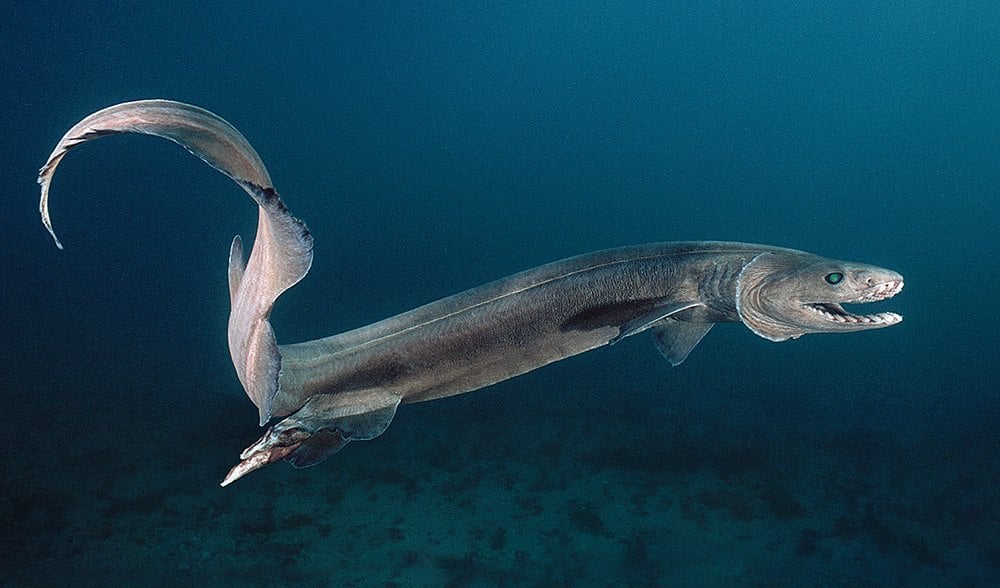The frilled shark is a peculiar looking shark that grows up to nearly seven feet long. Its loose, ribbon-like gills near its throat give the specimen its name. It is sometimes referred to as a “living fossil” because of its prehistoric qualities, like its fin placement, color, and impressive length. These creatures have been lurking our oceans for approximately 80 million years, and they have barely evolved during their time here on Earth.

Despite their terrifying appearance and enormous size, frilled sharks are not known to show aggression towards humans. No matter how friendly, I would not touch this beast with a 10-foot pole. Regardless, they live in extremely deep waters, usually ranging from 500-1000m deep in the ocean. It is extremely unlikely you will come across one of these. In fact, only two known species of this shark have ever been discovered. They were first discovered in Japan in 1884, and the only other species was discovered in 2009. It is safe to say that if you do not want to cross paths with these creatures, it is an easy task to do so.

Despite all of their other horrifying qualities, their mouths arguably take the cake. Frilled sharks have 300 teeth in total, arranged into 25 rows of trident-shaped points. The shape of their teeth ensures that their pray cannot escape once they have shut their jaws on their victim. Additionally, lining its mouth, frilled sharks have spines, called dermal denticles. Whether this creature is docile to humans or not, the sight of their maw is enough to make you stay far away.

Frilled sharks are located all over the world. However, they thrive in water 500-1000m deep in the ocean, so it is highly unlikely to come across one. However, there are a few documented cases of these critters making their way to the surface. In 2007, a Japanese fisherman discovered a frilled shark in Awashima Marine Park. It is speculated that the shark was sick or weak because of how unusual it is to see one in shallow waters. The shark unfortunately died only a few hours after it was caught. Additionally, the way this creature moves and swims renders it even more ominous and creepy. Because of their bodily make-up, they are naturally buoyant, and they tend to hover in the water. They move similarly to that of an eel or a snake, even striking their prey like one. They strike at their prey by quickly propelling themselves toward the victim, unhinging their jaw, and immediately trapping it with their pronged teeth.

Although creepy, these fascinating serpents act as an artifact of ancient sea creatures. Their primitive build is reflective of extinct sea creatures that lurked under the waves millions of years ago along with them. Their distinct look is due to their lack of evolution since when they appeared in the Late Cretaceous period. Although these creatures are rare to find, they are not endangered, most likely because they live too deep in the ocean for humans to go. These shocking animals not only serve as a glimpse into the past, but as a reminder of how strange and terrifying-looking some creatures on Earth are.
This is creepy.
It’s crazy to think that they’ve been here for 80 million years — yet haven’t evolved much at all. There must not be much selective pressure for them to do so (lack of competition, lack of predators, etc.). Their teeth don’t look very strong, though, so I’m assuming they prey on soft-bellied creatures instead of things like crabs and whatnot. Considering the depths that they dwell in, perhaps they are scavengers more so than hunters. That doesn’t seem likely, considering how you described them as snake-like hunters. Given how different they are from what we would normally consider to be sharks today, I wonder what the relation is between the Frilled sharks and modern sharks. It doesn’t seem to have the staple fin that most sharks do, so I wonder if people just saw it, got scared, and then threw it in with modern sharks because it looked freaky.